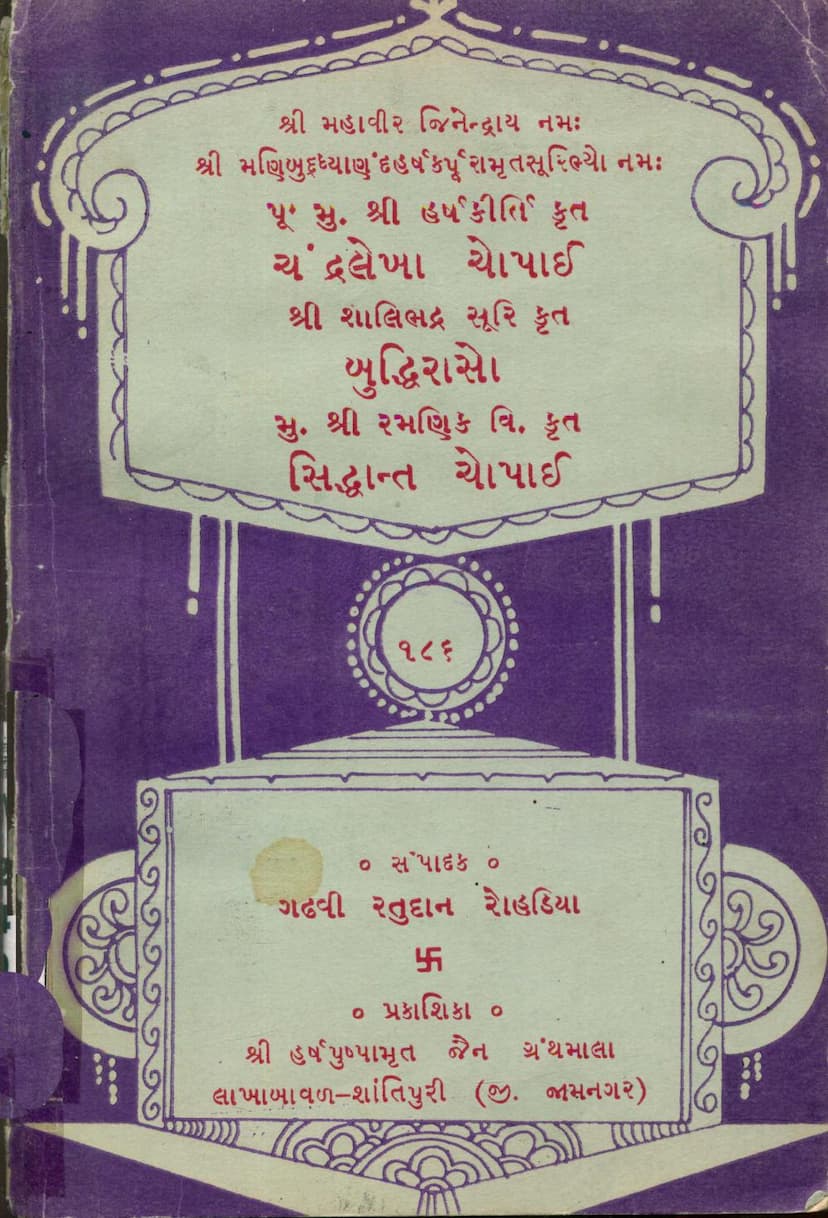Chandralekha Chaupai Buddhiraso Siddhant Chaupai
Added to library: September 1, 2025
Loading image...

Summary
This document is a collection of three Jain religious texts presented in the Chaupai (four-line stanza) poetic form, compiled and published by the Harshpushpamrut Jain Granthmala. The book aims to make these texts accessible and beneficial for the Jain community.
Here's a summary of each section:
1. Chandralekha Chaupai (by Muni Harshkirti)
- Theme: This Chaupai highlights the importance of Samayik (equanimity and meditation), a key practice for lay Jains (Shravaks and Shravikas).
- Narrative: It tells the story of Chandralekha, a virtuous woman who, through her practice of Samayik, is able to overcome injustice and positively influence her surroundings. The story emphasizes how her devotion and adherence to Dharma help her transform a wicked king and save her family.
- Core Message: The text underscores that true power lies in Dharma and righteous conduct. It presents Chandralekha as an ideal role model for Jain women, demonstrating how love and devotion can bring about positive change, even in difficult situations. It also reflects Lord Mahavir's message of compassion for all beings.
- Editorial Notes: The original text from 1566 CE had a complex language. It was simplified to be more accessible, with explanations for difficult words provided in footnotes.
2. Buddhiraso (by Shalibhadrasuri)
- Theme: This section, referred to as "Buddhiraso," focuses on the importance of wisdom and righteous conduct. It presents a collection of advice and moral teachings.
- Content: It offers guidance on various aspects of life, including:
- Personal Conduct: Avoiding gossip, not going to houses of solitary women, not being a runaway wife, and not listening to outside advice.
- Ethical Behavior: Not being jealous while eating, not taking anything from another's house without permission, not eating in the dark or with strangers, and not being arrogant or disrespectful to elders.
- Social Interactions: Avoiding enmity, not fighting with elders, not acting impulsively, and not engaging in deceitful practices.
- Financial Prudence: Giving donations according to one's means, not lending money to those who deal in usury, and avoiding gambling.
- Spiritual Practices: The importance of serving parents, the merit of donating, remembering the cyclical nature of life, and the consequences of sin.
- Core Message: The text provides practical, actionable advice for leading a virtuous and well-lived life, emphasizing wisdom, righteousness, and adherence to Jain principles.
3. Siddhanta Chaupai (by Muni Ramanikvijay)
- Theme: This Chaupai elaborates on Jain principles and practices, particularly focusing on the significance of devotion to the Jinas (Tirthankaras) and the importance of the Twelve Vows for lay followers.
- Content:
- Devotion to Jinas: It highlights that temples are not the only sacred places; the knowledge and teachings of the Jinas are equally important. It refers to scriptures like Gyatadharmakatha, Jivabhigama, and Rayapaseneya, emphasizing the role of devotion in Jainism.
- The Twelve Vows of a Layperson: It discusses the importance and implications of these vows for householders, drawing parallels to the vows of ascetics.
- Donations and Virtues: It touches upon the merits of various types of donations, the practice of Samayik (equanimity), and the significance of festivals and observances like Ashtami and Chaturdashi.
- Ethical Principles: It reiterates the importance of avoiding certain actions, such as consuming root vegetables, engaging in nighttime meals, and using tools like weapons or musical instruments inappropriately, all of which can lead to harm to life.
- Karma and Liberation: It emphasizes that understanding and practicing these principles, guided by the teachings of the Jinas, leads to the cessation of karma and ultimately, liberation.
- Core Message: The text stresses that a layperson's spiritual journey is guided by devotion, adherence to vows, and righteous conduct, all of which contribute to spiritual progress and eventual liberation.
Overall Publication Information:
- Publisher: Harshpushpamrut Jain Granthmala, Lakhabaval-Shantipur (Via Jamnagar).
- Editor: Gadhvi Ratudan Rohadiya.
- Dedication: The book is respectfully dedicated to Pujya Acharya Shri Vijay Jinendrasurishwarji Maharaj, who is described as instrumental in the revival of Jain literature.
- Support: The publication was supported by the Bauns Green Jain Sangh, London, and the Maninagar Jain Sangh, Ahmedabad, under the guidance of Pujya Acharya Shri Vijay Jinendrasurishwarji Maharaj.
- First Edition: 1988 CE, Vikram Samvat 2045.
In essence, the book is a compilation of valuable Jain teachings presented in a poetic format, aiming to educate, inspire, and guide readers on the path of Jain Dharma, with a particular emphasis on righteous conduct, devotion, and the practice of equanimity.